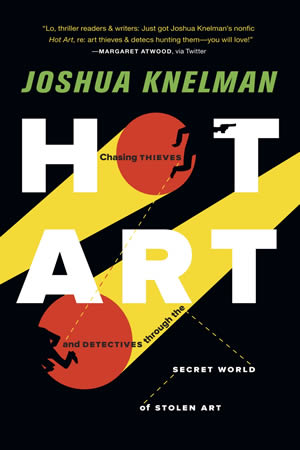 Aisles
Aisles
Staying Under the Radar
Hot Art: Chasing Thieves and Detectives through the Secret World of Stolen Art
by Joshua Knelman
Review by Holly Laycock
 very time I picked up Hot Art, no matter where I was—on the bus, in bed, on my breaks at work—I heard the slinky theme song from the 2002 film Catch Me If You Can, starring Leonardo DiCaprio. The soundtrack would start rolling as I followed Joshua Knelman around the world on his investigative hunt for art theft experts, and I began envisioning dotted lines emerging from the heels of bandits with aviator-clad detectives in hot pursuit. It was all very glamorous.
very time I picked up Hot Art, no matter where I was—on the bus, in bed, on my breaks at work—I heard the slinky theme song from the 2002 film Catch Me If You Can, starring Leonardo DiCaprio. The soundtrack would start rolling as I followed Joshua Knelman around the world on his investigative hunt for art theft experts, and I began envisioning dotted lines emerging from the heels of bandits with aviator-clad detectives in hot pursuit. It was all very glamorous.
But that Thomas Crown stereotype is precisely the opposite of the real world of stolen art, according to Knelman's sources. Instead, Hot Art chronicles Knelman's deepening immersion into the black market of stolen art over a period of five years, where he forms relationships with the world's preeminent art theft authorities—all ten of them—and one very talkative thief.
The trajectory of the book is a bit one-note, with each chapter reiterating that art theft is the fourth-largest black market in the world, with virtually no one policing it. However, the ridiculous antics of wannabe Thomas Crown thieves trying to jack a van Gogh and then sell it at an auction are endlessly entertaining. And I mean endless—the 312 pages of Hot Art are chock full of anecdotes of thefts gone awry, insider commentary from art theft investigators, cultural lawyers, and Paul, a.k.a. Turbo Paul, a.k.a. Turbocharger, a.k.a. Art Hostage, a.k.a. the meat of the book.
Paul's knowledge of the secret world of stolen art depicts the beginnings of the trade, from "knocking"—where a thief cases a house for valuables by posing as an art merchant—to the comfortable profession of middleman, essentially the highest rung on the criminal ladder that doesn't attract too much attention. Paul's key to not getting caught? "Stay under the radar." In other words, steal anything but a van Gogh, and you're likely to get away with it.
Knelman's voice throughout is frank and assumes an amusedly self-deprecating tone. Upon meeting a thief early in the book, Knelman finds himself left with a stolen print and a rather graphic threat (involving legs) ringing in his ear should the thief's identity ever be revealed: "I pictured myself showing up at the gallery...trying to explain how I'd got hold of it. Or ending up in a police station for a day while a detective questioned me. I wouldn't want to mention the thief: my legs."
His storytelling strikes a nice balance between profiles of his interviewees and amusing stories of thefts (both successful and not), and delivers a real understanding of how this multi-billion dollar illegal trade works. It also makes you realize, with a pang of injustice, what a wealth of culture we're actually missing. Holly Laycock has written, most recently, about the psychological and emotional reasons human beings have for acquiring and keeping "stuff."
Holly Laycock has written, most recently, about the psychological and emotional reasons human beings have for acquiring and keeping "stuff."


